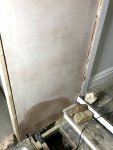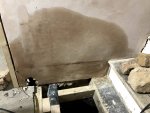thms
New Member
We're in the middle of an extension and we've had an existing internal walls boarded and skimmed. The plaster dried out initially and all looked good, but now it's gone damp at the bottom on two small sections of internal walls.
Initially the cause was thought to be a leak, but there is no sign of any water. As far as I know there are no pipes in the wall near the damp patch. The old lead pipe does go up into the wall away from this area but there is no sign of water leakage in this area. There was no sign of damp on these walls prior to the building work.
It's a mystery to the builders and me. Can't figure it out. Any help appreciated.
Looking below the damp area, there is a mini-basement area, filled with rubble and the brick below where the damp is worse looks a little damp here. Can't see any sign of a DPM/slate.
Pictures:
Initially the cause was thought to be a leak, but there is no sign of any water. As far as I know there are no pipes in the wall near the damp patch. The old lead pipe does go up into the wall away from this area but there is no sign of water leakage in this area. There was no sign of damp on these walls prior to the building work.
It's a mystery to the builders and me. Can't figure it out. Any help appreciated.
Looking below the damp area, there is a mini-basement area, filled with rubble and the brick below where the damp is worse looks a little damp here. Can't see any sign of a DPM/slate.
Pictures:
- 1st and 2nd pics - Major damp area which appears having previously drying
- 3rd pic - This is below this major damp area in the mini-basement/rubble pit
- 4th pic - Second damp area, around 90 corner to left of major damp area
- 5th pic - The internal walls prior to boarding and plastering
Attachments
Last edited:





